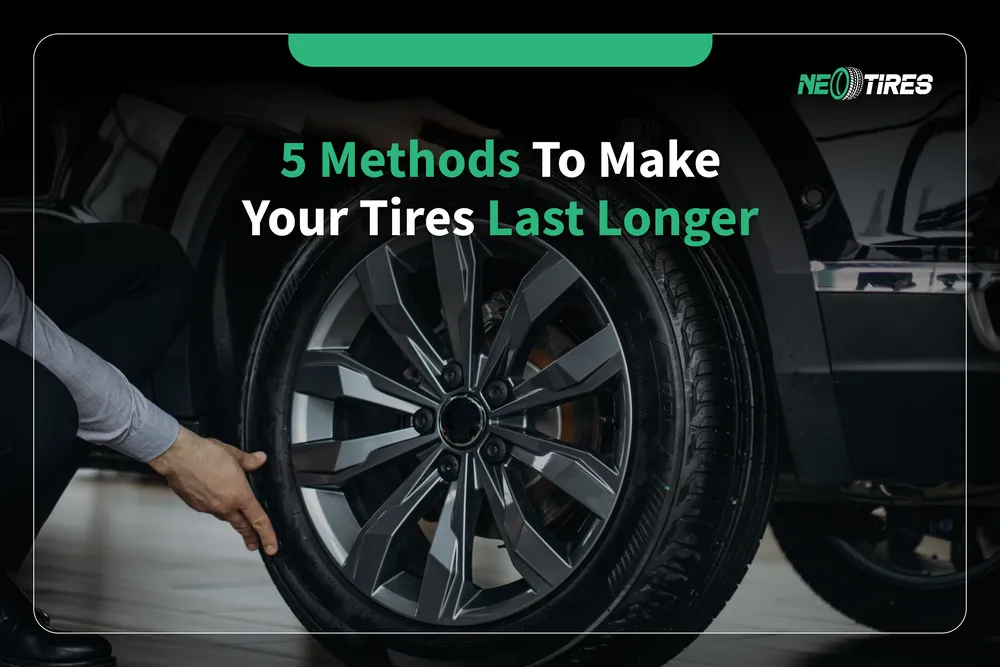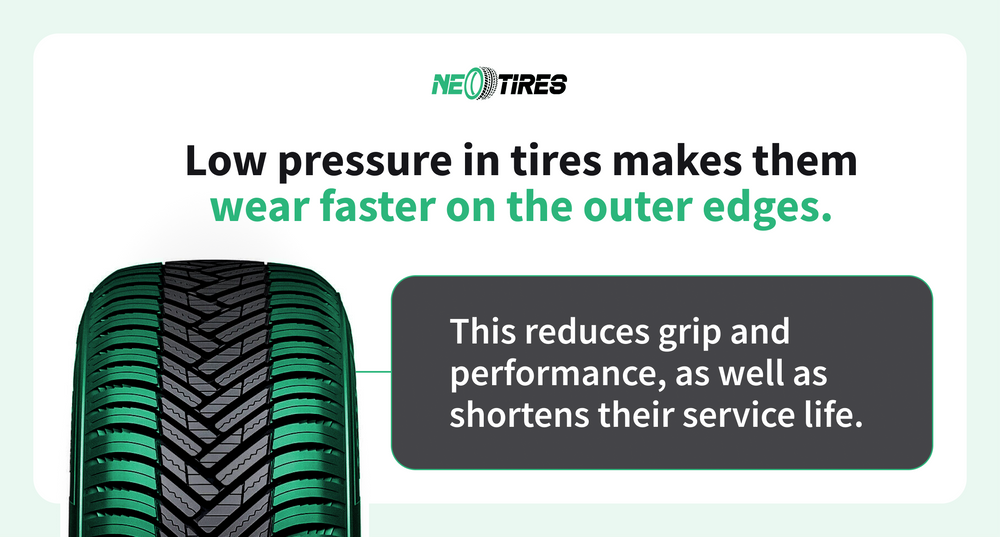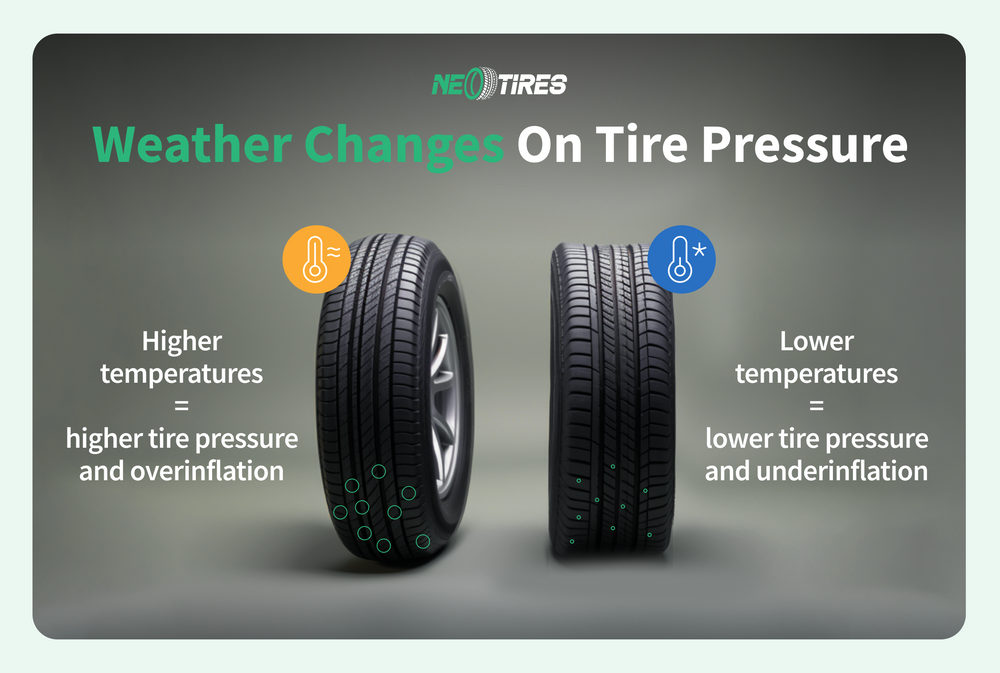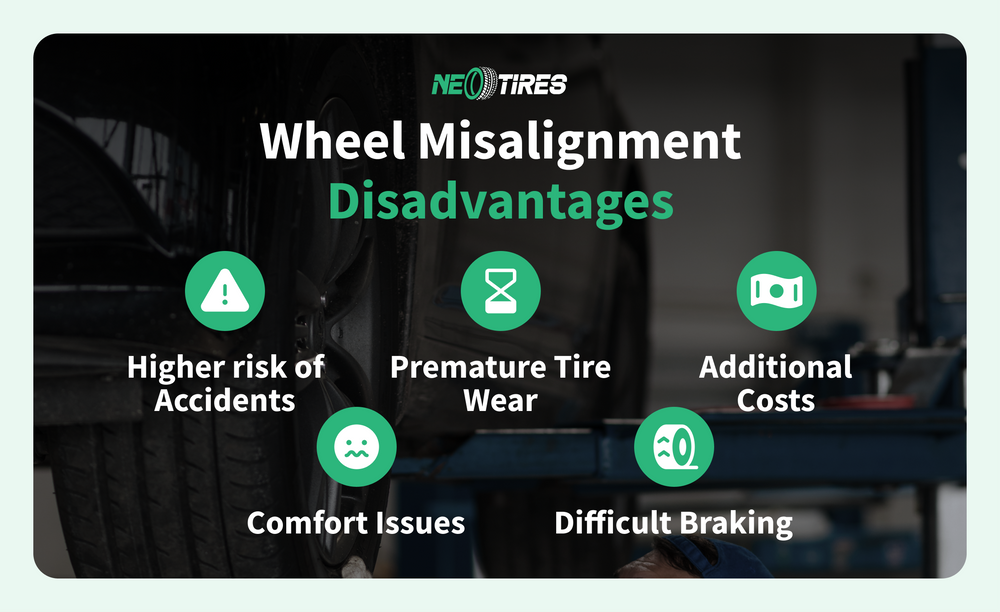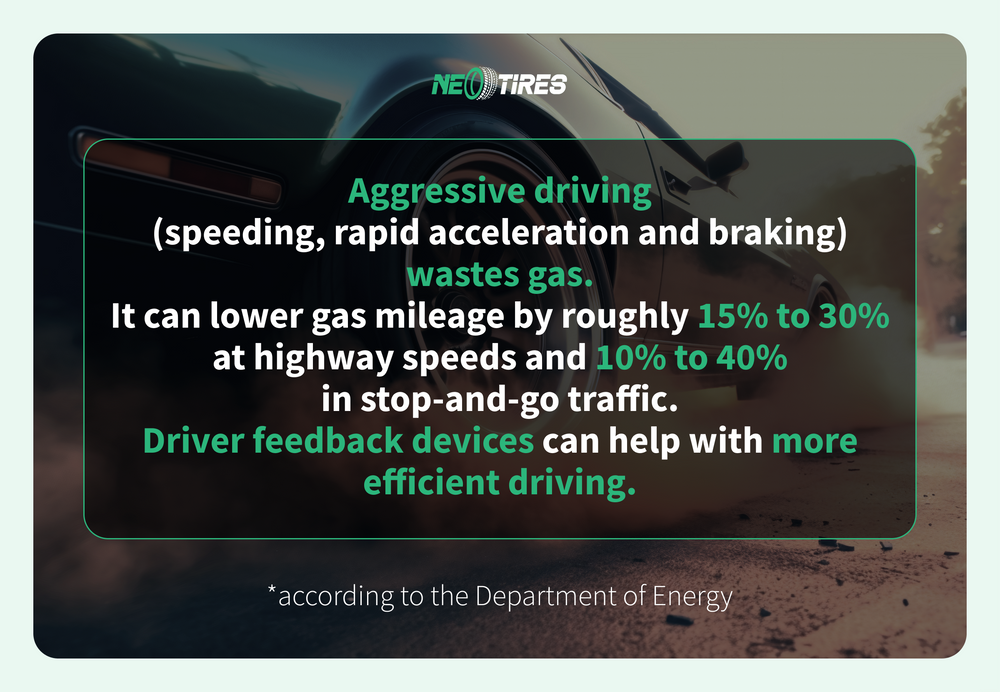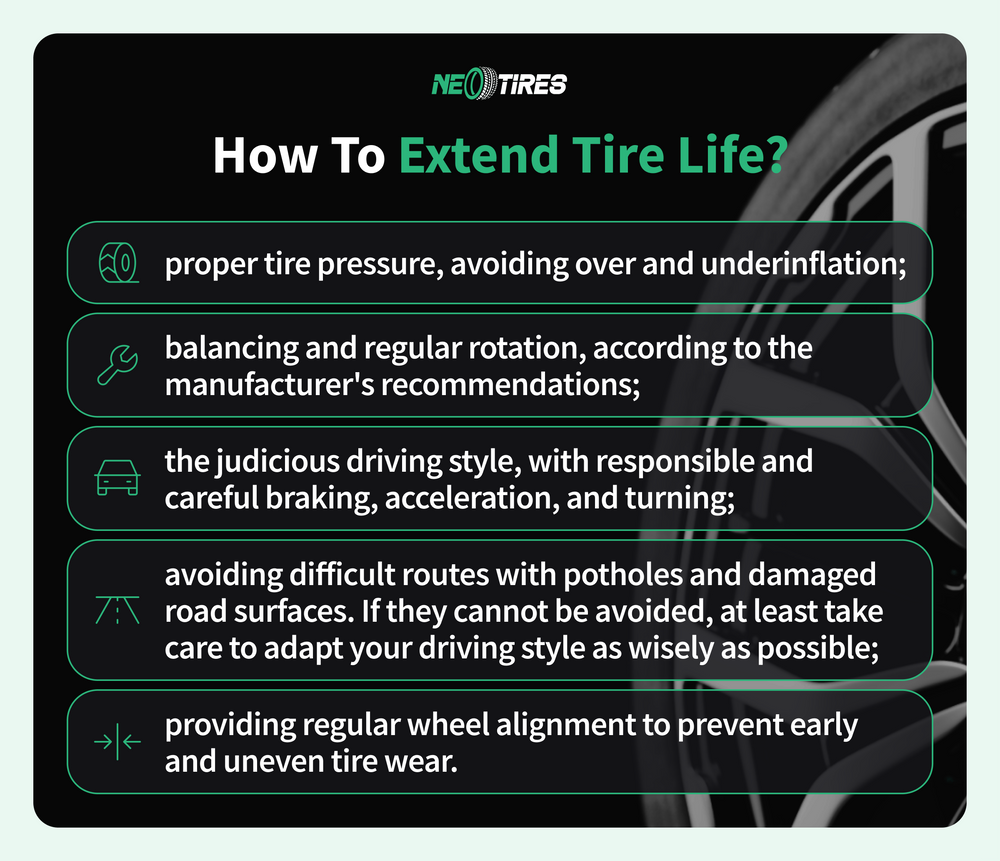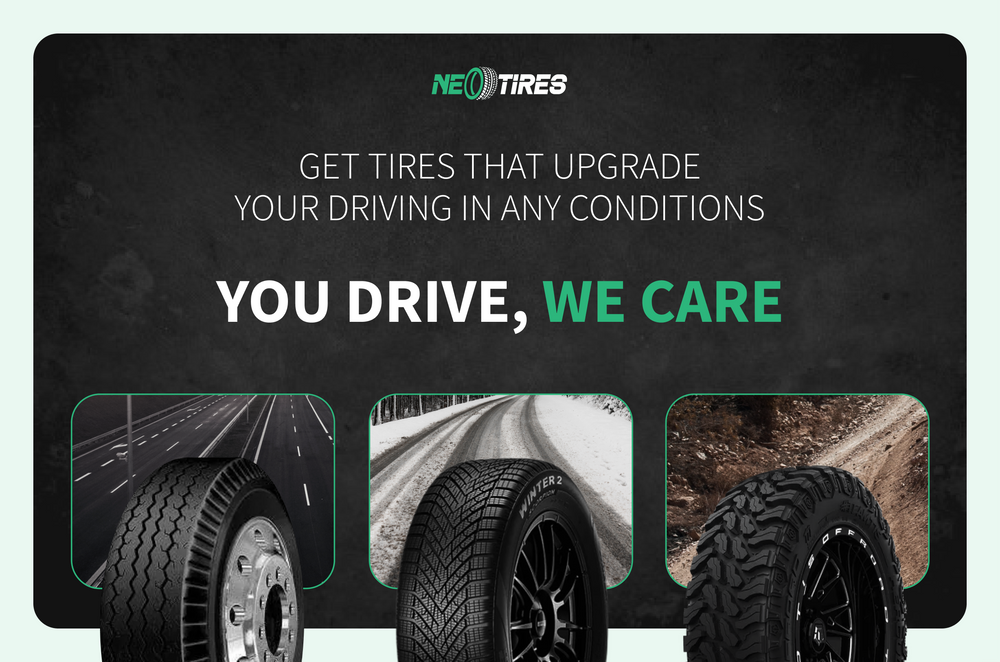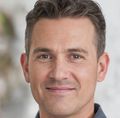Tires are responsible not only for moving the vehicle on the road but also for its fuel efficiency, overall performance, and safety. Tires can be a significant expense for drivers. Statistics from the U.S. Department of Transportation show that Americans spend about $20 billion annually on tires. In this section, we will focus on five methods that optimize tires' life to gain a better value for the money you spend on them.
Maintain Proper Tire Pressure
Proper tire pressure prevents premature damage caused by underinflation or overinflation and ensures even tread wear. Ensuring proper inflation in tires extends tire life and enhances overall performance.
How Does Tire Pressure Affect Tire Life?
Tire pressure directly influences tire life by impacting safety, performance, and tread wear. Underinflation and overinflation reduce tire life by causing excessive wear on the outer edges or the center tread. With excessive wear, the tire wastes its service life performance potential quicker than a properly inflated tire. According to NHTSA studies, too low tire pressure cuts tire longevity by about 25%.
4-Step Guide on How to Check Tire Pressure
The following 4-step guide will help you ensure proper tire pressure:
- Use a reliable pressure gauge;
- Measure tire pressure when cold (about 3 hours after or before driving);
- Remove the valve cap and press the gauge firmly onto the valve stem;
- Make sure that the tire pressure after adjustment coincides with the norms recommended by the manufacturer
How Often You Should Check Tire Pressure?
Pressure checks should be performed at least once a month and every time before starting long trips. Checking and adjusting pressure is a must if the TPMS indicates pressure drops. Tires can lose pressure for various reasons (osmosis, weather changes, air leakage). Checking once a week when spotting signs of underinflation (soft or flat appearance) is also recommended.
Rotate Your Tires Regularly
Tire rotation ensures even tread wear across all tires, extending their life. Regular tire rotation (every 6,000-8,000 miles) balances tire wear, improves performance, and extends tire longevity.
Understanding Tire Rotation Patterns
Tire rotation involves changing tire position on the same axle or between axles in rear cross, forward cross, or X patterns. The rotation pattern depends on the type of vehicle and tires. The common rotation patterns to consider are:
| Vehicle/tire type | Rotation Pattern |
| FWD Vehicles | Forward Cross Rotation |
| RWD Vehicles | Rearward Cross Rotation |
| 4WD/AWD Vehicles | X Pattern Rotation |
| Staggered Wheels | Side-to-Side Rotation |
| Directional Tires | Front to Rear Rotation |
Optimal Rotation Frequency
According to the Rubber Manufacturers Association, drivers are encouraged to rotate their tires every 6,000-8,000 miles. Yet, it is important to consider the recommendations of your vehicle manufacturer because some cars require more frequent rotation (high-performance cars, for example).
6 Benefits of Regular Rotation
Regular tire rotation can increase tire longevity by up to 20%. This process has at least six benefits, including even tire wear, improved handling, extended tire service life, fewer expenses, better road feedback, and higher driving safety.
Align Your Wheels
Wheel alignment maximizes tire service life by promoting even wear and reducing strain. Regular wheel alignment ensures proper contact between the tire and the road, reducing the risks of uneven wear.
Signs of Misalignment Reducing Tire Service Life
The following signs indicate a potential wheel misalignment:
- Uneven or rapid tire wear
- Squealing tires
- Vehicle pulling to one side while driving on a straight road
- Crooked steering wheel when driving straight
How Often to Check Wheel Alignment
Aligning the wheels once every 12,000 miles is a good practice to ensure optimal tire service life. For example, the Car Care Council encourages alignment once a year or at 12,000 miles, whichever comes first. This procedure is recommended whenever hitting a severe pothole or curve, especially if the vehicle squeals or pulls to one side.
Does Wheel Misalignment Impact Tire Life?
Yes, tire life reduces by about 30% with wheel misalignment. Due to improper tire position on the road, the tire wears rapidly developing thinner tread on the inner or outside borders of the tire. Other side effects of wheel misalignment include higher risks of accidents, comfort issues, difficult braking, and poor handling.
Good Driving Habits To Extend Tire Life
Good driving habits impact the tire's life by protecting its condition and maintaining optimal tread. Practices like avoiding sudden braking and acceleration, driving at moderate speeds, steering smoothly, and cornering vigilantly help reduce stress on tires, thus prolonging their lifespan.
Avoid Sudden Starts and Stops To Prolong Tire Life
Aggressive driving generates too much stress and heat build-up on tires. Both aggressive braking and acceleration cause premature tire wear. In addition, they increase fuel consumption. The U.S. Department of Energy states that aggressive driving is likely to lower gas mileage by 15% to 30% at highway speeds and 10% to 40% in stop-and-go traffic. This impact on fuel consumption is also accompanied by uneven tire wear.
Maintain Proper Speed to Prolong Tire Life
Faster tire wear and potential blowouts can be expected when driving at high speeds. Ignoring tire load and speed ratings puts a strenuous effort on the tires, reducing their lifespan.
Navigating Road Hazards
Be cautious of road hazards that can reduce tire lifespan. These include debris, potholes, and curbs that can damage tires, especially with aggressive driving. If possible, always opt for good road surfaces. If unavoidable, at least reduce speed and drive with maximum caution.
Conduct Regular Tire Inspections to Prolong Tire Life
Regular tire inspections allow drivers to address tire issues before they become too severe, ensuring longer tire life. Consistent pressure, tread wear, and damage checks help vehicle owners identify minor issues at an early stage. Tire inspections should be performed every month and before long trips.
What to Look For During Tire Inspections
A regular tire inspection focuses on checking the following:
- Uneven wear patterns: These indicate alignment or inflation issues
- Tread depth: Use the Penny Test (insert a penny into the tire tread with Lincoln's head upside down. If you can see all of Lincoln's head, it's time to replace the tire right away)
- Air level in all tires according to manufacturer's recommendations
- Cracks, bulges, and cuts in the tire sidewall
- Foreign objects stuck in the tire tread
When to Replace Tires
According to the Tire Industry Association, tire replacement is recommended when the Penny Test shows that the tire tread depth reaches 2/32 of an inch. Drivers should also pay attention to tires' built-in tread wear indicators (if any), as they indicate when it's time for replacement once they become visible.
Professional vs. DIY Inspections
Have your tires professionally checked in addition to DYI tire inspections (checking tire damage or air leaks, uneven patterns, tread depth, dry rotting, etc... ). Qualified specialists are trained to spot issues that are invisible to regular drivers. Spotting them early helps to take preventive measures so they don't get worse.
Tire Service Life: FAQs
How Can I Extend My Tires' Life?
Vehicle owners can extend the tire service life by adopting a judicious driving style (no hard acceleration/braking/cornering), ensuring timely maintenance procedures (rotation, alignment, balance, visual inspections), regularly adjusting tire pressure, and adapting speed according to road conditions.
Can A Tire Really Serve Up To 80,000 Miles?
Yes, some tires provide an 80,000-mile warranty, which means that the manufacturer guarantees the tire's performance for this specific distance. If a defect occurs within the 80,000-mile limit, the manufacturer commits to repairing the damage or replacing the tire.
However, drivers must fulfill their responsibilities regarding tire maintenance. This includes adhering to regular tire rotation, alignment, and balancing and adopting a safe and non-aggressive driving style. Failure to meet these responsibilities could result in the manufacturer canceling the warranty and denying coverage for any damages.
What Are Some of The Most Long-Lasting Tires?
From our experience, here are some tires with impressive mileage:
- Firestone Destination A/T2: SUV/CUV/Passenger LT/Pick-Up all-terrain tire;
- Toyo Open Country A/T III: A/S/Winter/SUV/CUV/PAssenger LT/Pick Up all-terrain tire;
- Falken WildPeak A/T Trail:All-season, SUV/CUV All-terrain tire;
- Yokohama Geolander M/T G003: SUV/CUV/Passenger LT/Pick Up mud-terrain tire;
- BFGoodrich Mud-Terrain T/A KM3: mud terrain tire;
- General Grabber X3: mud-terrain, light truck tire;
- Michelin CrossClimate2: SUV/CUV/Passenger tire;
- Michelin Defender LTX M/S: SUV/CUV/Commercial/ Passanger LT tire;
- Continental CrossContact LX25: SUV/CUV/Passenger LT tire;
- Michelin XPS Rib: Van/LT/Commercial tire;
- Michelin X-Ice Snow: Winter, SUV/CUV/Passenger tire.
Maximize Your Tire Lifespan!
While proper tire maintenance helps, high-quality tires make the difference in longevity, performance, and durability.
If your tires seem to be approaching the end of their lifespan, replacing them now can increase safety and save money in the long run.
Access the NeoTires catalog to find a wide selection of durable, efficient, and performing tires at an affordable price. Contact us if you are not sure what will best suit you. Our trained assistants will guide you to match your driving needs with the correct tires.
Why Trust NeoTires?
NeoTires is more than just a tire sales platform. Our team of enthusiasts and professionals is dedicated to offering various attractive tire deals and helping drivers enhance their driving performance while ensuring top-notch safety.
We conduct thorough testing, compare performance levels, and rigorously check tires in various conditions to provide an independent, unbiased, and objective assessment.
NeoTires content writers compile validated information from our technical specialists and tire industry professionals to deliver reliable tire reviews, driving tips, and essential tire knowledge.
Drive safe and choose your tires wisely!




